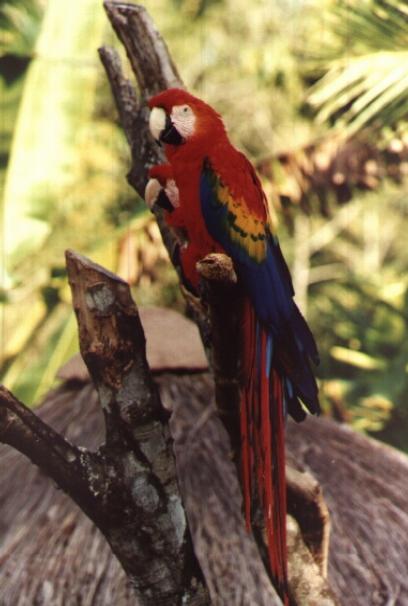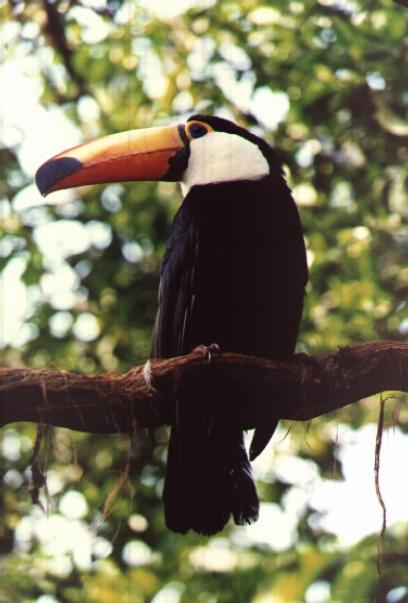My trip in Brazil
Brazil is a wonderful country. It ranks fifth in the world both in terms
of area and population. If there is any, it is a land of contrasts, between
pure wildness and intensive urbanization, or between exuberant wealth and
extreme poverty. I have seen a very small part of the land, essentially
located in the middle of its southern area. Here's some of the pictures
I took.
Ouro Preto
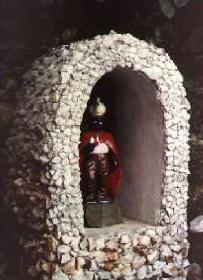 Ouro
Preto is the former capital of the state of Minas Gerais, and still the
historical center of this part of Brazil. The original strenght of the
city resides in the mining activity. One of the legends of the local mines
relates the story of the Chico Rey (the rich king). This man was
a deposed king of Africa who was brought, along with his tribe, in
slavery in Brazil. He lost all his family - wife, children - but one son
during the trip. He worked for years in an unprofitable mine. Finaly, his
master died, and as a reward for his fair work, he was given the mine.
But then, he found gold in it, so much that he was able to buy his liberty,
that of his son, and even the rest of the tribe ! The name of Ouro Preto
means "black gold", which refers to the color of the local ore that contains
gold. The city hosts a replica of the french Ecole des Mines, a
replica that remained close to the original mining activity, due to the
rich industrial history of Ouro Preto in this area.
Ouro
Preto is the former capital of the state of Minas Gerais, and still the
historical center of this part of Brazil. The original strenght of the
city resides in the mining activity. One of the legends of the local mines
relates the story of the Chico Rey (the rich king). This man was
a deposed king of Africa who was brought, along with his tribe, in
slavery in Brazil. He lost all his family - wife, children - but one son
during the trip. He worked for years in an unprofitable mine. Finaly, his
master died, and as a reward for his fair work, he was given the mine.
But then, he found gold in it, so much that he was able to buy his liberty,
that of his son, and even the rest of the tribe ! The name of Ouro Preto
means "black gold", which refers to the color of the local ore that contains
gold. The city hosts a replica of the french Ecole des Mines, a
replica that remained close to the original mining activity, due to the
rich industrial history of Ouro Preto in this area.
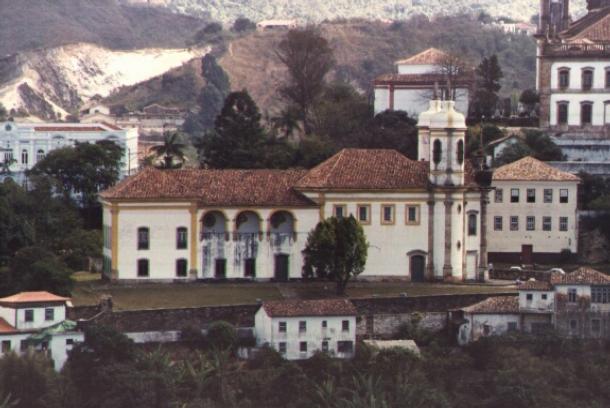 Ouro
Preto is also well-known for its numerous churches - a dozen in all
- whose sobriety in the exterior part contrasts with the luxury of the
internal decorations. One artist, the Aleijadinho (the little handicaped)
gave birth to many of the major sculptures in the city. Although the man
never went out of Ouro Preto, his fame eventualy spread to the entire Brazil.
As he was still young, he contracted a kind of leprosy that paralyzed his
legs and ate his fingers. But he kept on working, still making lots of magestuous
Chefs
d'Oeuvre, which gave him his name.
Ouro
Preto is also well-known for its numerous churches - a dozen in all
- whose sobriety in the exterior part contrasts with the luxury of the
internal decorations. One artist, the Aleijadinho (the little handicaped)
gave birth to many of the major sculptures in the city. Although the man
never went out of Ouro Preto, his fame eventualy spread to the entire Brazil.
As he was still young, he contracted a kind of leprosy that paralyzed his
legs and ate his fingers. But he kept on working, still making lots of magestuous
Chefs
d'Oeuvre, which gave him his name.
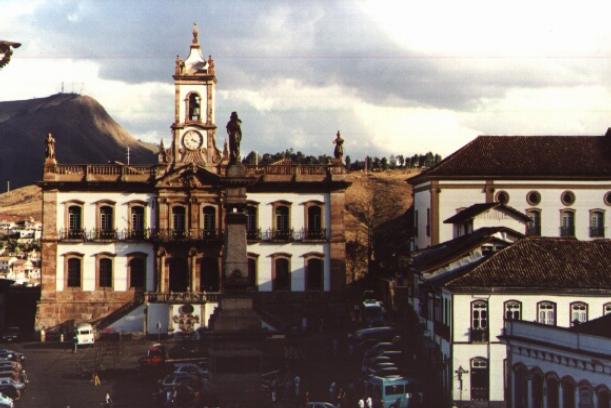 The city is also often mentioned for its contribution to the independence
of Brazil. One of the earliest leaders of the independentist movement is
probably Tiradentes, who founded a circle of contest against the
portuguese colons, called the inconfidencia (the unfaithfulness).
At the time of the French Revolution, this man organized clandestine meetings
and debates that became more and more popular. One of the main motivations
of the movement was the high level of taxation imposed by the portuguese
government and local delegates. In the picture, we can see the former city
hall, a building that appeared disproportionate for the small town of Ouro
Preto (at that time called Villa Rica, the Rich Town), while the
city suffered from lots of poverty. The building is now converted into
a museum (the museum of inconfidencia) that hosts religious arts, along
with testimonies of life during the three past centuries. The central monument,
along with the place, is dedicated to Tiradentes.
The city is also often mentioned for its contribution to the independence
of Brazil. One of the earliest leaders of the independentist movement is
probably Tiradentes, who founded a circle of contest against the
portuguese colons, called the inconfidencia (the unfaithfulness).
At the time of the French Revolution, this man organized clandestine meetings
and debates that became more and more popular. One of the main motivations
of the movement was the high level of taxation imposed by the portuguese
government and local delegates. In the picture, we can see the former city
hall, a building that appeared disproportionate for the small town of Ouro
Preto (at that time called Villa Rica, the Rich Town), while the
city suffered from lots of poverty. The building is now converted into
a museum (the museum of inconfidencia) that hosts religious arts, along
with testimonies of life during the three past centuries. The central monument,
along with the place, is dedicated to Tiradentes.
Iguaçu Falls
One of the most fascinating points of my visit was certainly the natural
site of the Iguacu Falls. The name of the falls means "great water" in
Guarani indian. The Iguacu rivers makes the limit between Argentina and
Brazil. Paraguay is a few miles westward. The falls are located in an area
still quite wild, and an important aspect of such a trip consists in discovering
local animals.
The brazilien border of the falls contains a national parc of birds with
lots of species from south america and the rest of the world. The animals
are kept in cages, but their environment is certainly larger than it would
be in many zoos. Also, as can be seen on the pictures, their environment
is well florished.
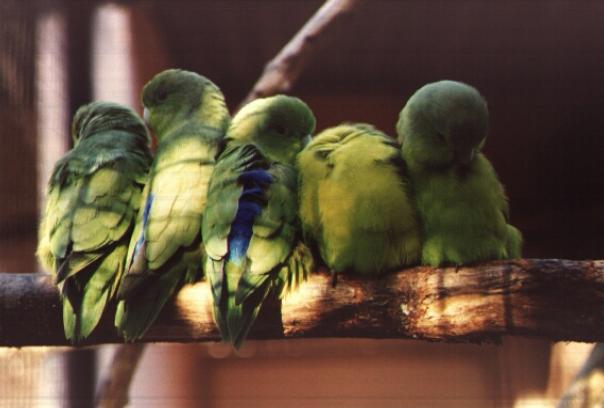 The falls themselves can be visited from the brazilien and the argentinen
sides. The brazilien side is, to my point of view a bit more panoramic,
and the argentinien, a bit closer to the phenomenon. Certainly both of
them merit to be taken attention.
The brazilian side.
The falls themselves can be visited from the brazilien and the argentinen
sides. The brazilien side is, to my point of view a bit more panoramic,
and the argentinien, a bit closer to the phenomenon. Certainly both of
them merit to be taken attention.
The brazilian side.
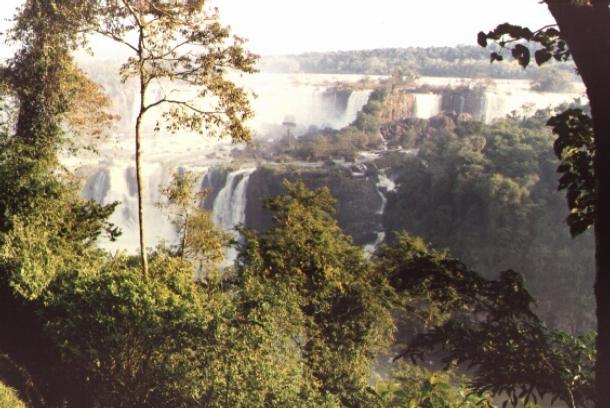
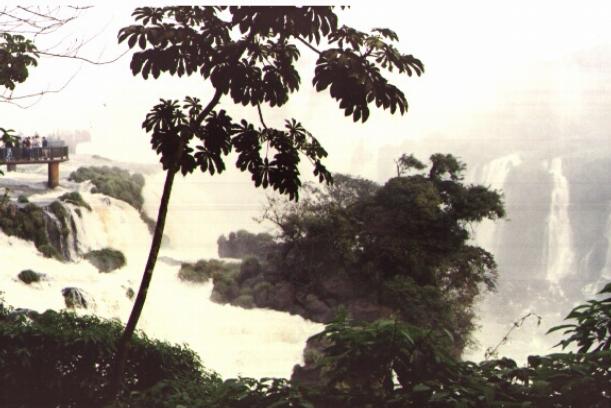
The Argentinian side.
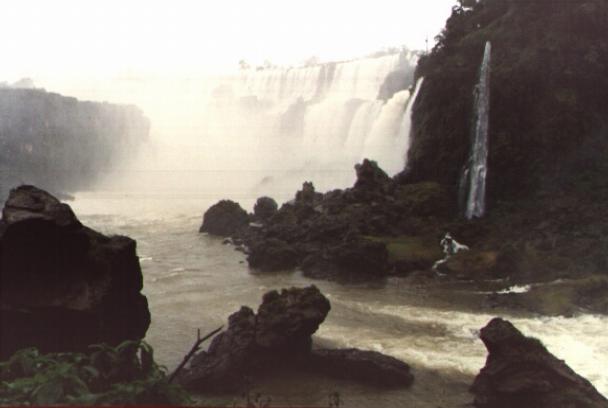
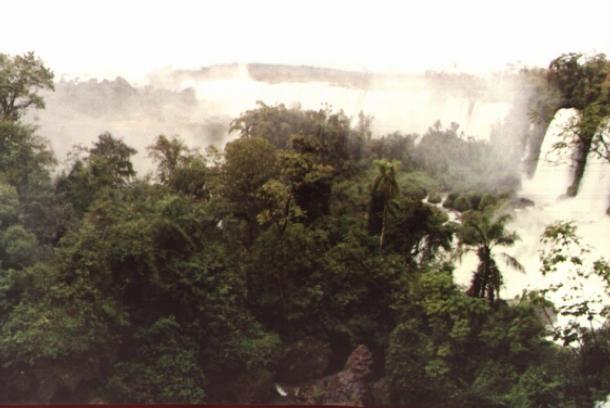
 Ouro
Preto is the former capital of the state of Minas Gerais, and still the
historical center of this part of Brazil. The original strenght of the
city resides in the mining activity. One of the legends of the local mines
relates the story of the Chico Rey (the rich king). This man was
a deposed king of Africa who was brought, along with his tribe, in
slavery in Brazil. He lost all his family - wife, children - but one son
during the trip. He worked for years in an unprofitable mine. Finaly, his
master died, and as a reward for his fair work, he was given the mine.
But then, he found gold in it, so much that he was able to buy his liberty,
that of his son, and even the rest of the tribe ! The name of Ouro Preto
means "black gold", which refers to the color of the local ore that contains
gold. The city hosts a replica of the french Ecole des Mines, a
replica that remained close to the original mining activity, due to the
rich industrial history of Ouro Preto in this area.
Ouro
Preto is the former capital of the state of Minas Gerais, and still the
historical center of this part of Brazil. The original strenght of the
city resides in the mining activity. One of the legends of the local mines
relates the story of the Chico Rey (the rich king). This man was
a deposed king of Africa who was brought, along with his tribe, in
slavery in Brazil. He lost all his family - wife, children - but one son
during the trip. He worked for years in an unprofitable mine. Finaly, his
master died, and as a reward for his fair work, he was given the mine.
But then, he found gold in it, so much that he was able to buy his liberty,
that of his son, and even the rest of the tribe ! The name of Ouro Preto
means "black gold", which refers to the color of the local ore that contains
gold. The city hosts a replica of the french Ecole des Mines, a
replica that remained close to the original mining activity, due to the
rich industrial history of Ouro Preto in this area.
 Ouro
Preto is also well-known for its numerous churches - a dozen in all
- whose sobriety in the exterior part contrasts with the luxury of the
internal decorations. One artist, the Aleijadinho (the little handicaped)
gave birth to many of the major sculptures in the city. Although the man
never went out of Ouro Preto, his fame eventualy spread to the entire Brazil.
As he was still young, he contracted a kind of leprosy that paralyzed his
legs and ate his fingers. But he kept on working, still making lots of magestuous
Chefs
d'Oeuvre, which gave him his name.
Ouro
Preto is also well-known for its numerous churches - a dozen in all
- whose sobriety in the exterior part contrasts with the luxury of the
internal decorations. One artist, the Aleijadinho (the little handicaped)
gave birth to many of the major sculptures in the city. Although the man
never went out of Ouro Preto, his fame eventualy spread to the entire Brazil.
As he was still young, he contracted a kind of leprosy that paralyzed his
legs and ate his fingers. But he kept on working, still making lots of magestuous
Chefs
d'Oeuvre, which gave him his name.
 The city is also often mentioned for its contribution to the independence
of Brazil. One of the earliest leaders of the independentist movement is
probably Tiradentes, who founded a circle of contest against the
portuguese colons, called the inconfidencia (the unfaithfulness).
At the time of the French Revolution, this man organized clandestine meetings
and debates that became more and more popular. One of the main motivations
of the movement was the high level of taxation imposed by the portuguese
government and local delegates. In the picture, we can see the former city
hall, a building that appeared disproportionate for the small town of Ouro
Preto (at that time called Villa Rica, the Rich Town), while the
city suffered from lots of poverty. The building is now converted into
a museum (the museum of inconfidencia) that hosts religious arts, along
with testimonies of life during the three past centuries. The central monument,
along with the place, is dedicated to Tiradentes.
The city is also often mentioned for its contribution to the independence
of Brazil. One of the earliest leaders of the independentist movement is
probably Tiradentes, who founded a circle of contest against the
portuguese colons, called the inconfidencia (the unfaithfulness).
At the time of the French Revolution, this man organized clandestine meetings
and debates that became more and more popular. One of the main motivations
of the movement was the high level of taxation imposed by the portuguese
government and local delegates. In the picture, we can see the former city
hall, a building that appeared disproportionate for the small town of Ouro
Preto (at that time called Villa Rica, the Rich Town), while the
city suffered from lots of poverty. The building is now converted into
a museum (the museum of inconfidencia) that hosts religious arts, along
with testimonies of life during the three past centuries. The central monument,
along with the place, is dedicated to Tiradentes.
